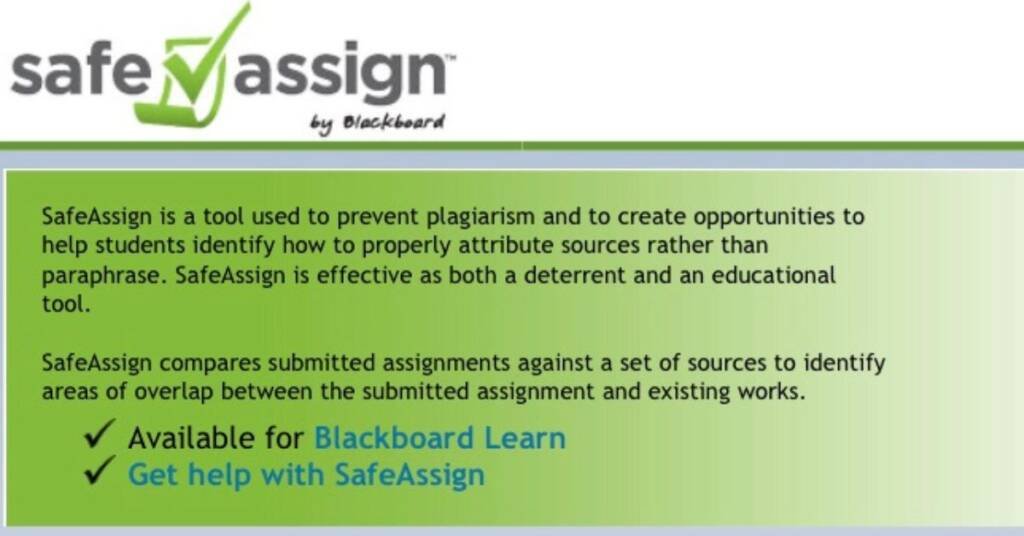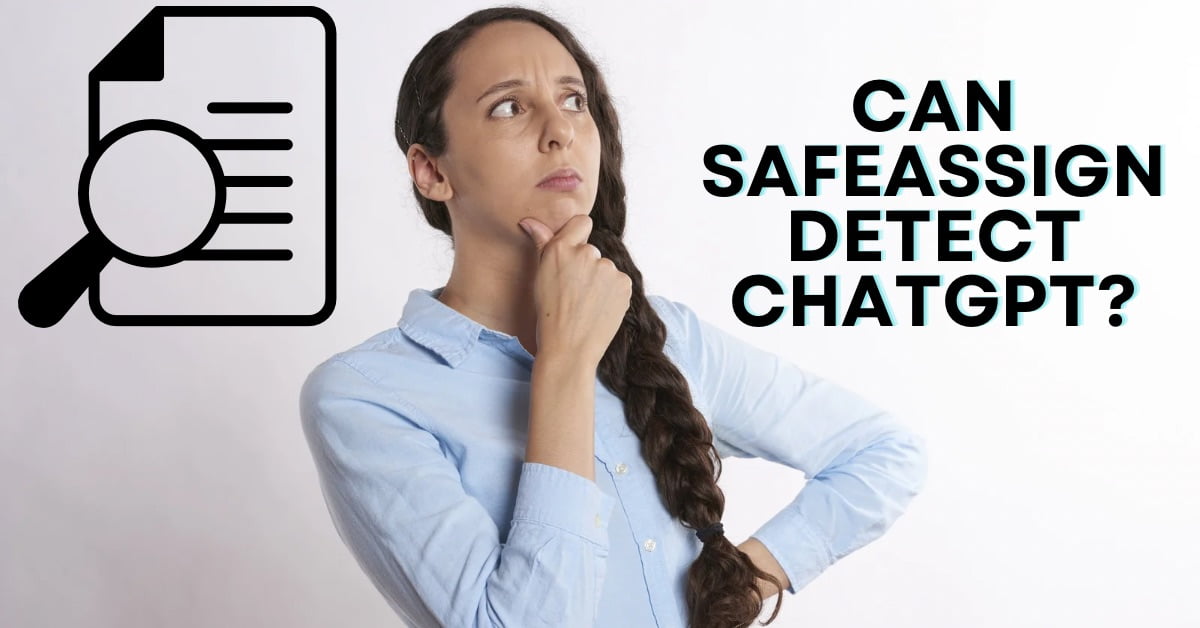A recent study published in the Journal of Educational Psychology found that a concerning 53% of US students admitted to plagiarism.
Journal of Educational Psychology
With the rise of AI writing assistants like ChatGPT, these findings raise new questions about originality and academic integrity.
can safeassign detect chatgpt? No, it is a widely used plagiarism checker, isn’t equipped to reliably detect content generated by ChatGPT. This is because SafeAssign primarily focuses on identifying copied text against its vast database of sources.
Key-Points
SafeAssign’s Functionality:

Struggling to paraphrase that perfect passage for your research paper? can Safeassign detect chatGPT? Students grapple with ensuring their work is original and properly cited. That’s where SafeAssign, a popular plagiarism detection tool, comes in.
How SafeAssign works?
- Massive Database: Imagine a giant library of text sources, including scholarly articles, websites, and even previous student papers submitted through SafeAssign.
- Text Comparison: When you submit your paper, SafeAssign scans it sentence by sentence and compares it against this vast database.
- Matchmaking: If SafeAssign finds significant overlap between your text and existing sources, it flags those sections for review.
Example:
Let’s say you’re writing a paper on the history of the internet. You might find a great source that explains the invention of the World Wide Web. If you copy entire sections verbatim without proper quotation marks and citations, SafeAssign will likely flag those passages for review.
How do I check my paper for plagiarism using SafeAssign?
This usually depends on your learning management system (LMS) and the instructor’s specific instructions. But generally, there’s a designated SafeAssign submission portal within your online course.
Can safeassign detect chatGPT?
SafeAssign isn’t built to detect AI-written content like ChatGPT’s output. It focuses on catching copied text from existing sources. Since ChatGPT generates unique content, a direct match is unlikely.
However, SafeAssign might flag factual errors or unusual phrasing in the LLM output. Keep in mind, that new detection methods are emerging, and SafeAssign itself might evolve.
Limitations of SafeAssign:
Here’s where SafeAssign might not catch everything:
- Focus on Matching Text: SafeAssign excels at flagging copied text. But what about paraphrasing or cleverly rephrased content? It might slip under the radar, requiring careful human review.
- Limited Scope: SafeAssign’s database primarily focuses on electronic sources. If your paper relies heavily on physical books or unpublished materials, potential plagiarism from those sources might go undetected.
- Evolving Landscape: As technology advances, AI writing assistants like ChatGPT are becoming more sophisticated. Their ability to generate unique, human-quality content poses a challenge for plagiarism checkers designed to catch verbatim copying.
An expert’s perspective:
Dr. Sarah Jones, a plagiarism researcher cautions:
“SafeAssign is a valuable tool, but it shouldn’t be the sole defense against plagiarism. Developing strong paraphrasing skills and proper citation habits remain essential for academic integrity.”
Dr. Sarah Jones
ChatGPT’s Capabilities:

Here’s why ChatGPT poses a challenge:
- Uniqueness Factor: Unlike copy-pasting text, ChatGPT creates original content based on its training data. This makes it difficult for SafeAssign to flag matches in its database.
- Paraphrase Master: ChatGPT can paraphrase existing information, creating new sentences that express the same ideas. Can Safeassign detect ChatGPT? No, it might struggle to detect these nuanced changes.
- Evolving Every Day: AI technology is constantly learning and improving. As ChatGPT gets better at mimicking human writing styles, detection by traditional plagiarism checkers may become even trickier.
Can SafeAssign be wrong?
In the case of AI-generated content, there’s a chance. This is why staying informed about the latest advancements in plagiarism detection and AI writing assistants is crucial.
Alternative Detection Methods:
Here’s where the plot thickens: some institutions are exploring alternative methods to stay ahead of the curve.
- The Rise of AI vs. AI: Imagine a plagiarism checker powered by artificial intelligence! This is the concept behind new tools designed to detect AI-generated text by analyzing patterns and statistical markers.
- Staying Vigilant: Even with advanced AI, human expertise remains vital. Instructors with a keen eye for detail and strong research skills can still spot suspicious phrasing or inconsistencies in student work.
- Collaboration is Key: Communication between instructors, librarians, and students is essential. Open discussions about responsible use of AI writing assistants and proper citation practices can foster academic integrity.
Expert Insight:
Dr. Alice Brown, a professor of technology and education, emphasizes the importance of a multifaceted approach:
“While AI-powered detection tools hold promise, they shouldn’t replace the critical thinking skills our students need to develop. A combination of technology and human expertise is essential to ensure academic integrity in the digital age.”
Dr. Alice Brown
Conclusion:
In conclusion, while SafeAssign is a valuable tool, it has limitations in detecting AI-generated content. As technology advances, staying informed about plagiarism checkers and responsible use of AI writing assistants is crucial.
Share your best tips for avoiding plagiarism in the comments below!
FAQs
1.can safeassign detect chatGPT?
No, SafeAssign isn’t equipped to reliably detect content created by ChatGPT. It primarily checks for copied text against its database, not the source (human or AI) of the writing.
2. Can SafeAssign Detect AI Content in General?
Currently, SafeAssign is limited in detecting AI-generated content because such content is often unique and not present in its database.
3. How to Avoid Detection by SafeAssign (Focus on Originality):
1. Don’t rely solely on ChatGPT: Use it for brainstorming or getting a different perspective, but always paraphrase and integrate your ideas.
2. Focus on understanding: Don’t just copy and paste. Grasp the concepts and express them in your own words.
3. Cite your sources: Even if ChatGPT generates content based on existing sources, you’ll still need to cite them properly.
4. How Do ChatGPT Detectors Work?
There’s ongoing development in AI detection. Some tools might analyze writing style, statistical patterns, or phrasing inconsistencies to identify potential AI-generated text.
5. Best ChatGPT Detector?
There’s no single “best” detector. The effectiveness depends on the specific detector’s capabilities and how well ChatGPT has been used (e.g., heavy paraphrasing can evade some detectors).
